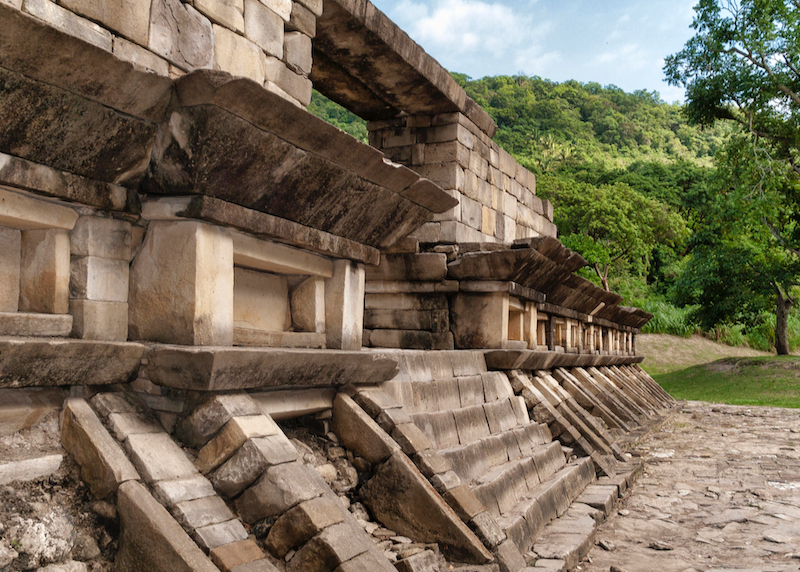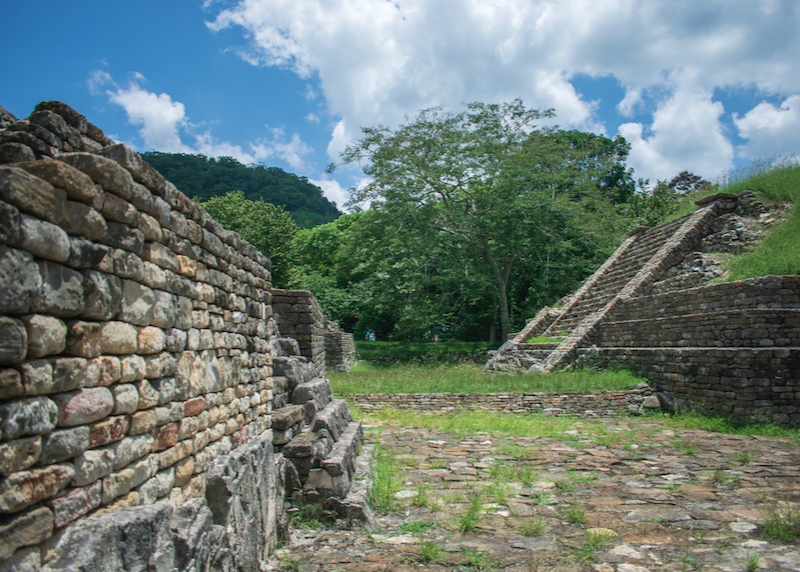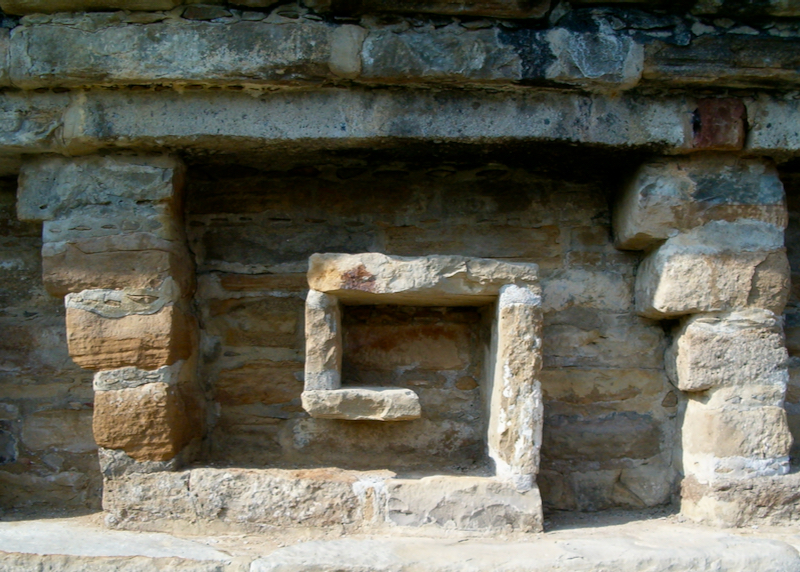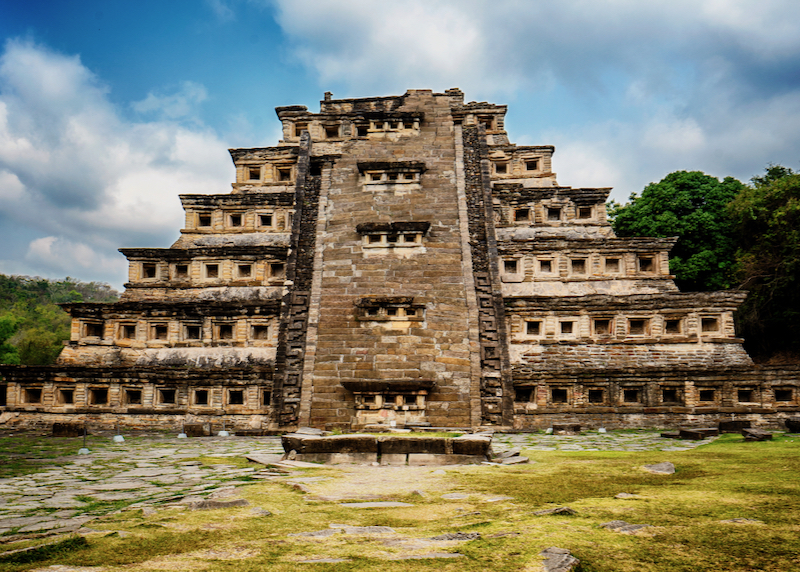Mexico › El Tajín Travel Guide
Updated: March 1, 2022
See Also
- Mexico – Where to Go
- Mexico – With Kids
- Mexico – Best Time to Visit
- Mexico – Best Beaches
- Mexico – Cancun vs Tulum vs Playa del Carmen
El Tajín is the most spectacular archeological site on Mexico’s Gulf Coast, and one of our favorites. It’s best known for its unique “niche” pyramids and flying voladores.

Amazing stone work on the pyramids of El Tajín.
Visiting El Tajín – Tips & Info
- Allow around 3 hours to visit the ruins
- The ruins are open daily 9am to 5pm and cost 80 pesos to visit
- Hire an official guide (once inside the entrance), or obtain a comprehensive written guide before touring the site, as there are very few signs in English.
- Guides charge around 400 to 500 pesos depending on the length of the tour – non-Spanish speakers should make sure their English is good before paying.
- The pyramids and ruined structures are all off-limits – it’s only possible to walk around them, not on or up them
- Local vendors sell snacks, drinks and handicrafts outside and inside the site – bring peso cash for snacks and drinks, but skip local specialties such as vanilla and honey and buy far better quality items in the main market back in Papantla.
- Visit the museum at the El Tajín entrance first to see carvings, murals and bits of pottery and statues salvaged from the ruins.
Visits to the site itself begin at the Plaza del Arroyo, once the city’s market square, surrounded by four pyramids (Buildings 16, 18, 19 and 20), which were once topped by temples. Building 16 features El Tajín’s distinctive style, its tiers filled with regularly spaced niches, like a giant stepped cabinet. Just to the north, the Central Zone features the wide avenue of the South Ball Court (“Juego de Pelota Sur”), smothered with bas-relief sculptures, and the famous Pyramid of the Niches (“Pirámide de los Nichos”), its six primary receding tiers punctuated with 365 mysterious niches. Nearby is the Building of the Paintings (“Edificio de las Pinturas”), a palapa roof sheltering its relief carvings and painted murals.
Beyond here lies the raised Tajín Chico area, once the home of the city’s elite, though only parts of the once grand structures survive. Buildings B and C are the most impressive and probably served as palaces. The Building of the Columns (“Edificio de las Columnas”) stands on a rise above Tajín Chico, with more bas-reliefs on its pillars.
From Tajín Chico you can walk down to the Great Xicalcoluihqui complex, still mostly smothered in jungle but with its immense walls giving a sense of its vast size.
Frequently Asked Questions about El Tajín

The site is surrounded by a lush green landscape.
Where is El Tajín?
El Tajín is a pre-Hispanic archeological site in the central Mexican state of Veracruz, 50km inland from the Gulf of Mexico. El Tajín lies around 10 km west from the city of Papantla, 255 km northwest from the city of Veracruz, and around 285 km northeast of Mexico City (by road).
How big is El Tajín?
The core site of El Tajín covers around 10 square kilometers (4 square miles), though smaller houses (as yet unexcavated) may have existed far beyond these boundaries. The area open to tourists today is around 146 acres. At its peak some 20,000 people would have lived here, but the site is uninhabited today.
What is the history of El Tajín?
El Tajín was founded in the 1st century AD by a civilization known as “Classic Veracruz”, though little is known about the people who built it; most theories point to the Huastecs or the Totonacs. The city flourished between 600 and 1200 AD, ruling much of the current state of Veracruz. El Tajín is thought to have been destroyed in the 13th century by fire, likely the result of an attack by the Chichimecs. Papantla was established by the Totonacs soon after, and El Tajín was gradually abandoned to the jungle. The Spanish “rediscovered” the ruins in 1785, but large-scale excavation and jungle clearance only began in the 1930s.
How do I get to El Tajín?
Most tourists visit El Tajín from the laid back city of Papantla, 10 km west – it’s a smaller but far more pleasant place to stay than industrial Poza Rica, which is 18 km northwest of El Tajín. Minibuses run between Papantla and the ruins (around 15 pesos) from Septiembre 16, behind Hotel Tajín. Taxis are also plentiful in Papantla and will wait at the ruins for an extra fee.

Unique pyramid details.
There is a small airport at Poza Rica, 30 km north of El Tajín, which in the past has been served by Aeromar with one daily flight to and from Mexico City – with the likely bankruptcy of Aeromar there are no plans for flights in the near future. Taxis from the airport will charge at least 350 pesos just to get into Poza Rica, and a lot more to El Tajín. Otherwise the nearest airports are at Veracruz and Mexico City – take a bus from either of these to Papantla. First-class buses from Mexico City take around 5 hours; from Veracruz it’s around 4 hours.
Taking an organized tour (with transport by bus included) is possible from Veracruz, but given the driving time, not recommended. It’s far better to travel independently and stay over night in Papantla.
What about Uber?
Uber is unavailable in the El Tajín and Papantla area – negotiate with regular taxi drivers instead.
Can I drive to El Tajín?
Driving from the US is possible – it’s a straightforward 460-mile (740 km) journey from Brownsville, Texas. However, care should be taken choosing a route, as the Mexican border states suffer from high levels of drug violence – driving at night should definitely be avoided. Foreign vehicles also need a Mexican “Temporary Importation of Vehicle Permit”, arranged at the border. It’s also possible to rent a car in Veracruz, and drive up from there (around 4 hours non-stop). Veracruz state is generally safe for tourists, but renting a car is not recommended for first-time Mexico drivers.
Do I need a car in El Tajín?
No. The site itself is pedestrian only and small enough to explore on foot.

The Pyramid De Los Nidos, with 365 windows, serves as a sun calendar with a temple on the top.
When is the best time to go to El Tajín?
December to April, when the weather is warm and relatively dry. El Tajín has a tropical climate – it’s very hot March to May, and humid and rainy June to October. The site can be busy during Mexican holidays or over the winter months – especially on Sundays – but this is still one of the least visited Mesoamerican sites in the country.
Where should I stay in El Tajín?
There is no accommodation in or around El Tajín itself, so staying in Papantla makes the most sense, in order to get an early start and have the site to yourself. There’s not a lot of choice however, with the best option Hotel Tajín (hoteltajin.mx/en), with city views, a small pool and decent restaurant. The Provincia Express (at Juan Enríquez 103-A) is a cheaper and convenient, if a little basic, alternative, right on the main plaza with a/c and wi-fi.
What are the best things to do in El Tajín?
There’s one main reason to come here – the ancient Maya ruins of El Tajín (officially “Zona Arqueológica El Tajín”), some of the most pristine in Mexico, though you can also check out the famous “voladores” just outside the main entrance. These “flying men” climb to a small platform atop a 30m-high pole before four of them spiral back down to earth on ropes while the fifth plays a flute and drum. It’s an ancient Mesoamerican ritual that’s well worth watching – the shows are free but expect to give a 20 peso tip.
What are the facilities like?
The main entrance to the site features an avenue of souvenir and handicraft shops, as well as plenty of places to eat and drink (vendors also roam the main site, but stock up on water before entering, just in case). The toilets are also here – there are no other restrooms in the site itself.
What currency is used in El Tajín?
The Mexican peso (often pre-fixed with a “$” sign) is the currency of Mexico and used in El Tajín – vendors in and around the site may accept US dollars (albeit at poor exchange rates), though entry to the site itself will be paid in pesos.
Bring lots of peso cash for small purchases like bottled water and snacks.
Is El Tajín safe?
Yes. Veracruz state and El Tajín itself has avoided the drug violence that has affected other parts of Mexico, and is generally free of petty crime.
Read More
- Cancun – Best Hotels
- Cancun – Family Hotels
- Isla Mujeres – Best Hotels
- Isla Mujeres – Family Hotels
- Los Cabos – Travel Guide
- Los Cabos – Best Hotels
- Los Cabos – Family Hotels
- Mazatlan – Best Hotels
- Mazatlan – Family Hotels
- Playa del Carmen – Best Hotels
- Playa del Carmen – Family Hotels
- Puerto Vallarta – Best Hotels
- Puerto Vallarta – Family Hotels
- Punta de Mita – Best Hotels
- Sayulita – Best Hotels
- Tulum – Best Hotels
- Tulum – Family Hotels